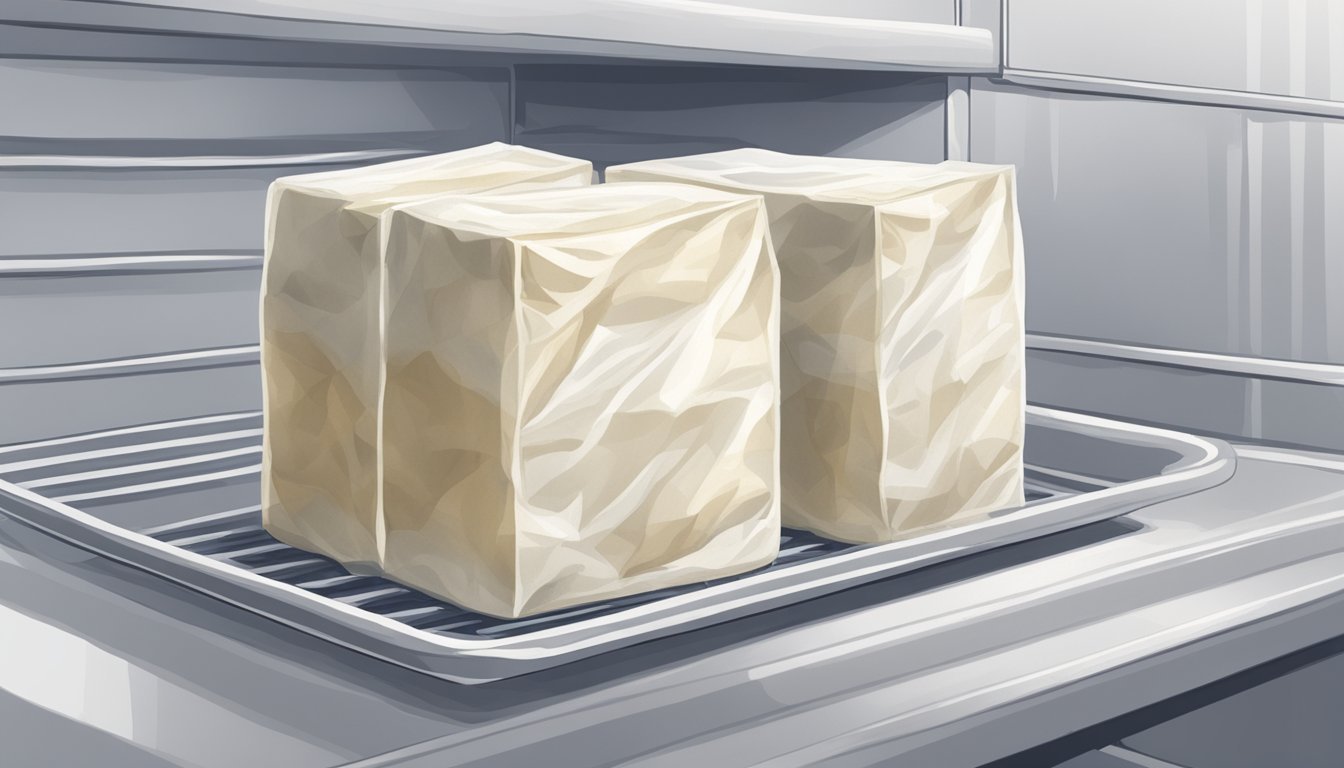How to Freeze Tofu for Better Texture
A Step-by-Step Guide
Freezing tofu is a method seasoned cooks often use to modify its characteristic texture. The process is simple and can transform the tofu's typically soft and smooth consistency into something more chewy and meat-like, which lends itself to a variety of cooking techniques. When tofu is frozen, the water inside it crystallizes, and upon thawing, these ice crystals create pockets within the tofu. This results in a firmer texture that is also more receptive to marinades and sauces, enhancing the overall flavor of the dish.
While the idea of freezing tofu might seem counterintuitive, especially when one considers the potential for moisture to impact texture negatively, the outcome is quite the contrary. The key to successfully freezing tofu lies in handling it correctly both before and after freezing. It's important to drain tofu of excess water to ensure optimal texture after thawing. Additionally, the way tofu is cut prior to freezing can affect its texture. Freezing tofu in larger blocks and then cutting it after thawing often yields a better result than freezing already cubed tofu.
Incorporating frozen tofu into cooking opens the door to a variety of culinary applications. Not only does it become crispier when pan-fried, but it also takes on a heartier feel that can stand up well in stews, stir-fries, and grills. This versatility is what makes freezing an excellent preparatory step for tofu, especially for those looking to explore plant-based cooking options without sacrificing texture or flavor.
Benefits of Freezing Tofu
Freezing tofu transforms its texture and extends its usability, making it a versatile ingredient for many dishes. Below, the specific benefits of this process are outlined, offering insight into why one should consider freezing tofu.
Improving Texture
Freezing tofu changes its cellular structure, resulting in a chewier and more porous texture. When water within the tofu freezes, it expands, creating ice crystals that puncture the tofu, leaving behind small holes after thawing. These characteristics make frozen tofu more agreeable to certain cooking styles where a firmer texture is desired.
Extending Shelf Life
The shelf life of tofu significantly increases when stored in the freezer. Fresh tofu typically lasts for about a week in the refrigerator, while frozen tofu can be safely used for several months. This makes freezing an excellent option for those who do not intend to consume tofu immediately or purchase it in bulk.
Enhancing Flavor Absorption
Due to the texture changes from freezing, tofu becomes more absorbent. The tiny holes created by the ice crystals allow marinades and sauces to penetrate deeper into the tofu. As a result, frozen tofu acts as a better sponge for flavors, making it ideal for dishes where tofu is meant to carry the taste of the marinades and sauces used.
Selecting the Right Tofu for Freezing
When freezing tofu, the type and quality are crucial for optimal texture enhancement.
Tofu Types and Textures
Tofu varies in consistency, which affects its texture post-freezing. Firm and extra-firm tofu are best suited for freezing as their lower water content leads to fewer ice crystals and a desirable chewy texture. Silken tofu, known for its creamy and delicate structure, does not freeze as well, often resulting in an unappealing texture. Soft tofu is similarly less ideal for freezing. For those seeking a dense protein source, super-firm tofu offers an excellent option, retaining a hearty texture even after freezing.
Checking Freshness and Quality
To ensure the best results, one should select fresh tofu. It should bear a uniform color, with no signs of yellowing, which can indicate age and a compromised flavor profile. Evaluating tofu's quality relies on an assessment of its physical characteristics:
Firmness: Press gently; if it retains shape, it indicates good quality.
Color: Fresh tofu should be white, not yellow.
Smell: It should have a mild, almost neutral scent; any sour or off smells suggest spoilage.
Packaging: Containers should be sealed with no excessive liquid pooling.
Note that alternative soy protein products like tempeh should not be considered interchangeable with tofu when it comes to freezing, as they possess distinct textures and compositions.
Preparation Before Freezing
Proper preparation of tofu before freezing is essential to enhance texture and ensure an even freezing process. Draining and pressing are key steps to remove excess water, while slicing and portioning allow for convenient usage post-freezing.
Draining and Pressing Tofu
To prepare tofu for freezing, one must first drain and press it to expel excess moisture. Tofu is a sponge-like substance that retains water, so removing as much liquid as possible is crucial to improving texture. The user should begin by removing the tofu from its packaging and draining the water it's stored in.
Step-by-Step Draining: Place the tofu on a tilted board or a rack in the sink to let water drain freely.
Pressing: Use a tofu press or rig a makeshift press by wrapping the block of tofu in paper towels or a clean kitchen cloth, placing it on a plate, and setting a heavy object such as a pot or a book on top. Press for 15 to 30 minutes until the tofu feels significantly firmer and most of the water has been squeezed out.
Note: It's important to evenly distribute weight across the tofu while pressing to avoid uneven texture.
Slicing and Portioning
After the tofu has been thoroughly drained and pressed, the next step is to slice it into desired shapes and portion for freezing. This not only ensures that the tofu freezes evenly but also makes for convenient use in future recipes.
Cut Tofu: Slice tofu into preferred sizes whether slabs, cubes, or another shape that suits the intended use.
Separate Portions: For ease of use, portion the slices according to typical recipe requirements before freezing. One may use freezer bags or an airtight container for storage.
If the tofu is not being used all at once, separating into smaller portions is recommended to avoid having to defrost the entire block later. It's also advisable to lay out the pieces on a baking sheet to freeze individually before transferring to containers or bags, preventing them from sticking together.
Freezing Process
When preparing tofu for freezing, the goal is to achieve a firm texture and maintain its freshness. Proper packaging and the application of freezing techniques are essential for optimal results.
Packaging Tofu for the Freezer
To preserve tofu's quality, it should be stored in an airtight container or a sealable freezer bag. This helps prevent the formation of ice crystals, which can deteriorate the texture. If freezing an entire block, one can keep it in its original packaging, provided it’s completely sealed. For portioned tofu, the following steps are advised:
Drain the tofu to remove excess liquid.
Wrap the tofu in paper towels and press to eliminate additional moisture.
Cut the tofu into desired portions if necessary.
Place the tofu on a baking sheet or plate, ensuring pieces are not touching, and flash freeze until solid.
Transfer the frozen tofu to an airtight container or sealable freezer bag, removing as much air as possible.
Freezing Techniques and Tips
For an improved texture, they may consider two main techniques for freezing tofu.
Freezing Whole: This simple method involves freezing the tofu in its unopened and undrained package. The tofu must be given ample time to thaw later.
Freezing in Portions: This involves cutting and storing the tofu in desired sizes before freezing. To freeze, they can follow these steps:
Slice or cube the tofu after pressing out excess water.
Arrange the tofu on a baking sheet in a single layer to prevent clumping.
Freeze the tofu until the pieces are solid to ensure they maintain their shape.
Store the frozen pieces in an airtight container or a sealable freezer bag to safeguard against freezer burn.
Regardless of the method, it's important to label the container or bag with the freeze date to keep track of freshness.
Thawing and Cooking Frozen Tofu
Successfully thawed and well-cooked tofu can transform a dish with its enhanced texture and flavor absorption. The right thawing method sets the stage for fantastic culinary results.
Thawing Methods for Tofu
One may thaw tofu by simply leaving it in the refrigerator for several hours or overnight. This slow process ensures that the tofu thaws evenly. For more immediate use, placing the frozen tofu in a bowl of room temperature water can expedite the process, typically taking about 3-4 hours. It is important to keep the tofu in its packaging or a sealed bag during this water bath to prevent it from absorbing too much water. Another quick method is using a microwave with a defrost setting, which requires monitoring to ensure the tofu doesn't start to cook.
Cooking Techniques for Thawed Tofu
Once thawed, tofu is ready for a variety of cooking methods:
Stir-frying: Thawed tofu can be cut into cubes or strips and stir-fried quickly over high heat until golden, absorbing the flavors of the dish.
Pan-frying/Seared: Achieve a crispy exterior by pan-frying or searing slices of tofu in a hot pan with a little oil until each side is crisp and browned.
Grilling: For a smoky flavor, one can marinate tofu slices and grill them, ensuring they're turned carefully to prevent sticking.
Braising: Tofu can be braised in a flavorful liquid in a covered pot, absorbing the liquid's flavors as it cooks.
In soups: Add cubed tofu to soups and allow to simmer, enhancing the soup’s protein content without altering the texture significantly.
Hot pot: Thawed tofu is perfect for hot pot, soaking up the broth's flavors as it cooks in the communal pot.
Deep-frying: For a crunchy exterior, completely dry the tofu and deep-fry it until it's golden and crispy. This works exceptionally well with thawed tofu because of its firmer texture.
Incorporating Frozen Tofu into Recipes
Frozen tofu offers a more firm and chewy texture, making it incredibly versatile for various culinary applications. It can absorb marinades and sauces more effectively, elevating the flavor profile of tofu dishes.
Creative Uses for Frozen Tofu
Frozen tofu is not just suitable for classic stir-fries; its enhanced texture allows it to stand out in a multitude of recipes. Scrambles benefit from frozen tofu's firmness, giving the dish a substantial bite. Braises take advantage of its ability to soak up flavorful sauces, resulting in rich and satisfying meals.
Here are some specific ways to incorporate frozen tofu into cooking:
Stir-fried dishes (What wine goes well with stir-fried dishes?): Cut the tofu into cubes or strips and stir-fry until golden brown; the firm texture holds up well against high heat and vigorous stirring.
Braised tofu: After thawing, braise in sauces like soy or a mix of aromatic spices to infuse deep flavors.
Tofu scrambles: Crumble the tofu and cook with vegetables and spices for a high-protein breakfast option.
Marinating and Seasoning
Marinating thawed tofu can transform it into a flavor-packed component of any meal. Due to the texture freeze-thawing imparts, tofu becomes akin to a sponge, ready to absorb a variety of marinades. Here's how to maximize flavor:
Preparation: Cut tofu into desired shapes and gently press out any remaining liquid post-thawing.
Marinade choices: Opt for flavorful sauces such as soy sauce, teriyaki, or custom blends with garlic, ginger, and other aromatics.
Marinating time: Allow the tofu to sit in the marinade for at least 30 minutes, although a few hours or even overnight will deepen the flavor profile.
By incorporating frozen tofu that has been skillfully marinated and seasoned, chefs can transform simple ingredients into culinary delights with robust and nuanced tastes.
Storing Leftover Frozen Tofu
When one has leftover frozen tofu, it is vital to store it correctly to maintain its texture and flavor. Proper storage extends shelf life and ensures the tofu remains safe for consumption.
Storage Life and Best Practices
Shelf Life: Once frozen, tofu can be stored in the freezer for up to three months. The shelf life of frozen tofu is contingent on the stability of freezer temperatures and proper packaging.
Best Practices:
Temperature: Always store frozen tofu at a consistent freezing temperature. Fluctuations in temperature can cause ice crystals to form, affecting texture.
Packaging: Remove as much air as possible before sealing tofu in an airtight container or freezer bag. This reduces freezer burn and preserves quality.
Thawing: To defrost, transfer the frozen tofu to the fridge and allow it to thaw overnight. Avoid defrosting tofu at room temperature to minimize the risk of bacterial growth.
Refreezing: It is not recommended to refreeze tofu that has been thawed, as this can further degrade its texture and can lead to food safety issues.
By adhering to these guidelines, one ensures their leftover frozen tofu remains a versatile and enjoyable ingredient.
Frequently Asked Questions
In this section, you will find in-depth answers regarding the popular method of freezing tofu to improve its texture and ability to absorb flavors.
Common Concerns and Solutions
Why does freezing tofu change its texture?
Freezing tofu is a technique known to alter its texture. As tofu freezes, the water content within turns to ice and expands, creating a more porous structure. This results in a chewier and spongier consistency once defrosted, which allows it to better absorb flavors and marinades.
How long should tofu be frozen to achieve the best texture?
Tofu should be frozen for at least 24 hours to ensure a noticeable change in texture. Some prefer to freeze it longer — often several days — for a more pronounced effect.
Can you freeze tofu without draining it first?
It is possible to freeze tofu directly in its original packaging without draining. Upon thawing, the excess moisture should be pressed out to achieve the desired texture.
Does freezing tofu make it more or less moist?
Freezing tofu tends to make it less moist. The freezing process expels some of the water content, leaving a drier product that can soak up marinades and sauces more effectively.
Will freezing tofu always result in a chewy texture?
The resulting texture of frozen tofu can vary between chewy and spongy depending on the exact freezing and thawing methods. Consistently freezing tofu can help achieve a reliably chewy texture.
What is the recommended way to thaw frozen tofu?
Thawing tofu can be done effectively in the refrigerator, which takes about a day. Other methods include thawing on the counter for a quick defrost or using a microwave for an even faster approach; however, the refrigerator method is often preferred for maintaining an even texture.
How do you cook frozen and thawed tofu?
Once thawed, tofu should be pressed to remove excess water and can then be cooked as normal. It can be pan-fried, baked, or grilled, and it will have a greater capacity to develop a flavorful and pleasingly firm exterior.
Conclusion
Freezing tofu transforms its texture and enhances its ability to absorb flavors, an ideal method for those who prefer a meatier and chewier consistency. The process is simple and can preserve the tofu for extended cooking use. When tofu is frozen, the water inside its structure forms ice crystals, which modify the tofu's texture to be spongier and more absorbent.
Before Freezing:
One should press the tofu to remove excess moisture, ensuring a firmer end product.
Cutting the tofu into portions before freezing is advisable if one does not intend to use it all at once.
After Thawing:
The previously frozen tofu becomes more absorbent, perfect for soaking up marinades and sauces, resulting in flavorful and marinated tofu dishes.
The consistency is improved for specific recipes, such as stir-fries or grills, providing a firmer and denser bite similar to a chewier texture found in meat.
Remember, a tofu press is not strictly necessary but helpful in achieving a consistent firmness throughout the tofu. Freezing does not significantly alter the nutritional value of tofu, but it does offer a versatile and enjoyable change in its texture, suitable for a diverse range of recipes.






